
Minolta made a wide variety of manual-focusing, 35mm film, SLR cameras starting in 1958 -- possibly more models
than any other company. We have two ways for you to explore Minolta's SLR cameras:
Minolta made a wide variety of lenses for each of the SLR cameras. For details on the lenses, check
out our lens pages.
Just as there are several companies that make lenses that fit on Minolta cameras, there are several companies
that make cameras that use Minolta lenses. For details on these cameras, check
out this page. And to confuse things even more, Leica modified different Minolta models and sold them as Leica
cameras which do not accept Minolta lenses. Here is a list of these cameras.

(1958) The SR-2 was Minolta's first SLR. A very advanced camera for the time, the SR-2 had a winning combination of features: an instant return mirror with a semi-automatic lens -- only the second Japanese camera to accomplish this feat. It was replaced two years later by the more advanced SR-3.

(1959) The SR-2 was a remarkable camera at the time, but it was also financially far beyond the reach of the average shutterbug. Minolta produced the SR-1 in 1959. It was a less expensive version of the SR-2 -- with fewer features.

(1960) The SR-2 was a very advanced camera for the time, but it had two major drawbacks. First, it was expensive and second, it lacked a built-in meter. These were enormous drawbacks and kept Minolta SLR camera sales down. Minolta addressed the first issue by producing the SR-1, and it addressed the second with the Minolta SR-3.

(1960) On the original model of the SR-1, the shutter speed dial had to be raised to change the shutter speeds. On this model, you could change speed without raising the dial. Another minor change was the addition of a bayonet mount to the viewfinder for the new viewfinder accessories. Despite being an economy model, a black version was also available.

(1961) On the original model of the SR-3, the lens diaphragm action was "semi-automatic". On the SR-3 (model b) the diaphragm retained the open position even after the shutter was released. In addition, a new CdS meter was available. The SR-3 (model b) was replaced in the following year, 1962, by the more advanced SR-7, which included a meter that was built into the body of the camera -- yet another Minolta revolution!

(1961) On the original model of the SR-1, the lens diaphragm action was "semi-automatic". On this model, the diaphragm action was fully automatic.

(1961) The ER was the only Minolta SLR with a non-removable lens -- a 45mm f2.8 lens. The big advantage was that this camera offered shutter-preferred automatic exposure control -- or manual control. Just select the shutter speed and the built-in selenium meter sets the aperture. Quite a convenience at the time. Two accessory lenses were available.

(1962) The previous models of the SR-1 lacked a meter. This version of the SR-1 added a provision for a clip-on meter -- the "SR-1" was moved to the other end of the camera.

(1962) The Minolta SR-7 raised the bar in the photographic industry. It was the first Japanese 35mm SLR to be fitted with an internal CDS meter. In this model, the large, external, clip-on meter is moved inside the camera body, but the size of the camera body did not increase. The meter was not TTL, and the meter readout was on the top of the camera, but it was still quite an accomplishment.

(1963) Yet another version of the SR-1 with modest changes. On this model, the film counter was moved from the left-hand side of the body to the right-hand side.

(1963) The original Minolta SR-7 had a couple of shortcomings. This model corrected these. First, the model A lacks a battery on-off switch. The model B has one. Last, but not least, on the original model, it was necessary to waste an exposure in order to lock up the mirror. The new version allowed the device to be used without firing a frame.

(1965) A modified version of the SR-1, the model V switched to a type B body.(see previous models). There were other changes as well. For example, it has a new rectangular viewfinder and a mirror lock-up was added.

(1965) A modified version of the SR-7, the model V switched to a type B body. (see previous models). There were other changes as well. The previous models had a circular viewfinder, so a new accessory shoe and all other eyepiece attachments had to be reconfigured. The Minolta logo is now placed on the angled part of the prism (where the earlier was on the flat front). Another change was that the low range button on the back of the camera has been moved to the front of the camera -- in the same place as the lens release button on the later X-series cameras.

(1965) The meter on the SR-7 did not see exactly what the lens saw, since the meter was not behind the lens. The next step up from the SR-7 was to develop a camera with a through-the-lens (TTL) metering system. Minolta developed a prototype camera of the "stop-down" genre, but thankfully it was never marketed. Dubbed the SR777, it looked much like the earlier Minolta SLR cameras.

(1966) The SRT101 was the first production Minolta SLR with through-the-lens metering. Just as important, it accomplished this TTL metering at full aperture -- a radical innovation at the time. To top it off, the new Minolta meter readout is now inside the viewfinder -- another incredible innovation. You no longer needed to remove your eye from the viewfinder to adjust the shutter speed and f-stop -- and take a picture. But a whole new set of lenses needed to be designed to mechanically couple to the built-in meter. The MC ("meter-coupled") Rokkor lenses were born.

(1967) The SRT101 was a superb camera, but financially it was beyond the reach of many consumers. Minolta understood this, and one year after the introduction of the SRT101, it released the SR-1s. This is really an updated and improved version of the SR-1 (model V). It has a faster top speed -- 1/1000. Think of it as an SRT101 without the meter.

On this model, the black, finely-milled, shutter speed dial is replaced with a chrome shutter speed dial with three rows of teeth. A few other cosmetic changes were made.

(1970) Minolta understood that many photographers wanted a motor-driven camera, and in 1970 they developed a motor-driven camera -- the SR-M. It was different in several ways. While it came with a built-in motor-drive and included a mirror lockup, it lacked a meter and a self-timer.

(1971) The SRT101 was a fabulous camera, but it was expensive. Five years after the introduction of the SRT101, Minolta added the SRT100 which is a scaled-down, less expensive version of the SRT101. It maintained the main feature of the SRT101 which was it's TTL metering system, but at significant savings. It was replaced with the SRT200 of 1975.

(1971) On this model, the mirror-lockup was dropped.

(1972) While the SRT100 of 1971 was in some ways a step down from the SRT101, Minolta took a giant step up the year after the release of the XK. "Revolutionary", was what the reviewers called the XK at the time. Minolta decided to get into the professional camera market dominated by Nikon and Canon -- with a twist. They designed the world's first, professional 35mm SLR camera with automatic, TTL exposure control.

Minolta sold the XK in Europe as the XM.

Minolta sold the XK in Japan as the X-1.

(1973) The SRT101 was amazingly convenient for a manual-exposure camera -- but still, it lacked some important convenience features. An improved version of the SRT101 came out seven years after the introduction of the SRT101 -- the SRT102. In this model, in addition to the shutter speed, the f-stop is displayed in the viewfinder. Now there is no need to ever take your eye away from the viewfinder while taking a picture. The SRT102 also has multiple exposure capability and a built-in hot shoe. Last, but not least, a split-image rangefinder is added to the middle of the focusing screen. It was replaced with the SRT202 of 1975.

Japanese version of the SRT102 (model a).

European version of the SRT102 (model a).

(1973) Like the SRT100 but with a few changes. Marketed for Kmart and a few other large department stores.
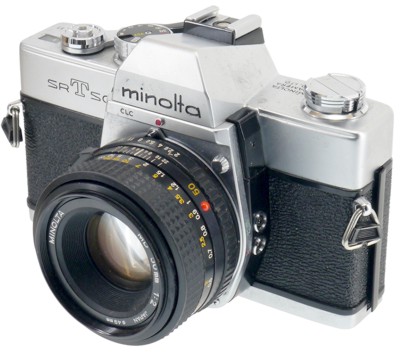
(1973) A modified SRT100 with a couple of additional features. Designed for, and sold by, Sears, Roebuck & Co.

(1974) Same features as the SRT102 (model a), but the mirror lock-up has been removed.

Japanese version of the SRT102 (model b).

European version of the SRT102 (model b).
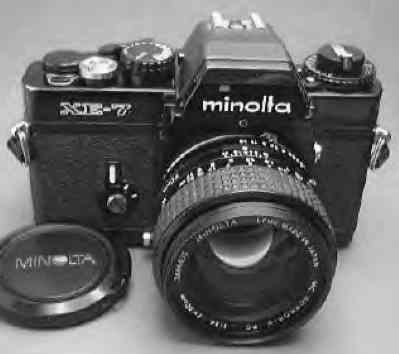
(1974) The XK was fabulous, but it was designed for the professional market -- and was expensive. Think of the XE-7 as an XK without the interchangeable heads -- although there were other differences as well. It was basically an SRT102 with automatic exposure. It had aperture-preferred automatic exposure, metered-manual and manual modes of exposure. There are many who say this is the best 35mm camera EVER made, by anyone! It lived on by becoming the basic ingredient of the Leica R3.

European version of the XE-7

Japanese version of the XE-7.

(1975) In 1975, Minolta "upgraded" the original SRT series to the 200 series. Actually, there was very little difference between the two series of cameras. The SRT200 was a modified version of the SRT100. The main difference was that it now had a top speed of 1/000 instead of 1/500.

(1975) European version of the SRT200 (model a).

(1975) Modified version of the SRT101. The features are the same, but a hot shoe replaced the cold shoe of the SRT101.

(1975) Japanese version of the SRT201 (model a).

(1975) European version of the SRT201 (model a).

(1975) Modified version of the SRT102. The mirror lockup was removed, but a film advance window and film memo holder were added.

Japanese version of the SRT202 (model a).

European version of the SRT202 (model a).
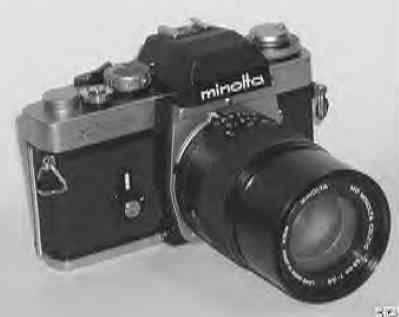
(1976) The XE-7 of 1974 was a marvelous cameras but it was expensive, so Minolta opted to produce a less expensive version the next year -- the XE-5. It maintained the major feature of the XE-7, which was automatic exposure control, but dropped several features that Minolta saw as less important.
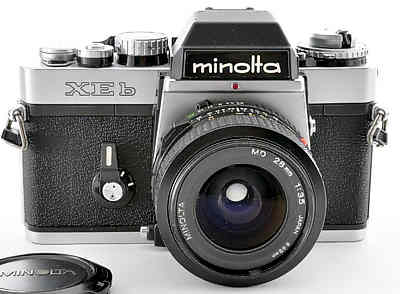
Japanese variant of the XE-5. Same as the XE-5, but with multi-exposure capability.

The only thing the Minolta XK lacked was a motor drive. So in 1976, Minolta came out with the XK MOTOR. It's basically the same as the XK with a built-in (i.e., non-detachable) motor drive. A new, faster, silicon-based, metering head (AES) was needed to keep up with the motor drive, but all XK heads will fit and work correctly.

European version of the XK MOTOR

Japanese version of the XK MOTOR

(1976) At the same time that Minolta produced the XK Motor, they made some modifications to the original XK. The obvious difference is that they replaced the ASA/DIN chart on the film door with the film-tab holder of the XK Motor. Sold in the North American market.

Minolta sold the XK in Europe as the XM.

Minolta sold the XK in Japan as the X-1.

Variant of the SRT201. The advances are bi-prism focusing spot, mirror lock-up (on some versions), and safe-load signal. Like its predecessor, it was marketed for sale by KMART and a few other large stores. In 1979, a one CDS cell version which lacked the CLC featrue replaced the original. This second model was only made in chrome.

(1977) The XE-7 was a superb camera, with automatic exposure, but Minolta faced new challenges from other companies. Other manufacturers were producing cameras with convenience features similar to the XE-7, but that were significantly smaller and lighter. First, there was the Olympus OM-2 (1975), and then the Pentax ME (1977). Minolta got into the fray -- but with a twist. How about the world's first multi-mode camera which could be set for aperture-preferred or shutter-preferred expsoure automation? That's the XD-11. Plus, Minolta threw in a new, smaller body style with lots of new features. To take advantage of the new shutter-preferred features of this camera, a new line of lenses, the MD Rokkor-X series was introduced.

European version of the XD-11 (model a)

Japanese version of the XD-11 (model a)

(1977) Minolta knew that the XD-11 was expensive and designed for the serious amateur. It also knew that it needed to produce a less expensive camera retaining the automatic exposure feature. The XG-7 was produced at the same time as the XD-11, and had a similar, compact body styling. The XG-7 lacked the shutter-preferred exposure mode of the XD-11, as well as other features. The XG-7 was the first in a long line of XG cameras.

European version of the XG-7.

Japanese version of the XG-7.

(1977) In 1977, Minolta "upgraded" the original SRT200 camera with a few, largely cosmetic, features.

(1977) European version of the SRT200 (model b).

(1977) A continuation of the SRTSC and a variant of the SRT200. It had the standard improvements of the SRT200 series. Sold exclusively by Sears.

(1977) In 1977, Minolta "upgraded" the original SRT201 camera with a few, largely cosmetic, features.

(1977) Japanese version of the SRT201 (model b). It was produced in chrome & black bodies, but is so hard to find we can only show the top plates. Perhaps it never made it to the streets!

(1977) European version of the SRT201 (model b).

(1977) Ever-so-slightly, modified version of the SRT202 (model a).

Japanese version of the SRT202 (model b). It was produced in chrome & black bodies, but is so hard to find we can only show the top plates. Perhaps it never made it to the streets!

European version of the SRT202 (model b).

(1978) On the Model B, the chrome, metal meter compensation tab is changed to a black, plastic tab -- see top, right-hand corner of camera.

European version of the XD-11 (model b)
Japanese version of the XD-11 (model b)

(1978) A simpler, less expensive alternative to of the XG-7 with fewer features.

(1978) More expensive alternative to the XG-7 with additional features, like an Acute Matte screen.

(1979) Less expensive version of the XD-11. It still has both aperture and shutter-preferred automation, but has less information in the viewfinder, among other feature changes.

(1979) The change on the XD-11 (model c) is that the 1/125 shutter speed is now marked in green to use with the shutter-preferred automatic exposure mode -- which has a green "S". All other speeds (except X) are still in white.
European version of the XD-11 (model c)
Japanese version of the XD-11 (model c)

(1978) In 1978, Minolta "upgraded" the original SRT200 camera with a few, largely cosmetic, features.

(1978) European version of the SRT200 (model c).

(1978) In 1978, Minolta "upgraded" the original SRT201 camera with a few, largely cosmetic, features.
(1978) Japanese version of the SRT201 (model c).

(1978) European version of the SRT201 (model c).

(1979) Improved version of the XG-SE with more feastures such as displaying the manually-selected f-stop in the viewfinder.
Japanese version of the XG-9.

(1979) In 1979, Minolta dropped the CLC metering feature from its SRT200 camera. There were a few other, largely cosmetic, changes as well.

(1979) European version of the SRT200 (model b).

(1979) In 1979, Minolta dropped the CLC metering feature from its SRT201 camera. There were a few other, largely cosmetic, changes as well.
(1979) Japanese version of the SRT201 (model d).

(1979) European version of the SRT201 (model d).

(1979) Last version of the SRTMC-II. It lacked the CLC feature of the SRTMC-II (model a). This second model was only made in chrome.

(1979) Second and last version of the SRTSC-II. It lacked the CLC feature of the SRTSC-II (model a).

(1980) The Model D has the exposure compensation dial in the same location as the Model A, B & C but the small, black, control tab is now on the prism side of the camera -- see left side of image. Perhaps this makes it more difficult to move unintentionally.

European version of the XD-11 (model d)
Japanese version of the XD-11 (model d)

(1980) Late variant of the XD-11. It has the added feature of a diopter adjustment of the viewfinder. Marketed only in Japan.
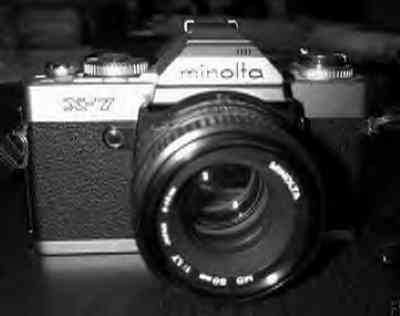
(1980) To compete with the all-automatic exposure offerings from other manufacturers, like the Pentax MV of 1979, Minolta created the X-7 in 1980. It did not have any manual shutter speeds settings, and was designed to work in auto-exposure mode only.

(1981) Updated version of the XG-9 with a new body style.

Japanese version of the XG-M.

(1981) Variant of the XG-1, with the new Minolta logo and a few new features.

(1981) A simplified XG-1 with no manual exposure mode.

(1981) A fifth late variant (1981 and later) -- Model E -- shows the new "all caps" MINOLTA logo, but is otherwise the same as the Model D.

European version of the XD-11 (model e)
Japanese version of the XD-11 (model e)

(1981) Late variant of the XD-11. Differs from the model A in that it has the new Minolta logo. Marketed only in Japan.

(1981) The X-700 has the same body styling as the XG-M. The big difference is that this is the first Minolta SLR to offer programmed-exposure automation. It also offers aperture-preferred exposure control and manual mode. The programmed exposure mode was designed to be used with MD lenses. In addition, it offers TTL flash mode with special flash units.

(1982) Same features as the XG-1n (model a), but in an XG-M body style.

(1982) A slightly upgraded version of the X-7 (model a), the X-7 (model b) added a couple of features, but was still strictly automatic.

(1983) A less expensive version of the X-700 without programmed exposure.

Japanese version of the X-570.

(1983) Minolta's first, and only "focus-confirmation" camera. Very similar to the X-570 in features, the X-600 was soon replaced by the auto-focus Maxxum camera 7000 in 1985.

(1984) A less expensive version of the X-570 with fewer features, such as no aperture readout in the viewfinder.
European version of the X-370.

(1985) Modified X-370. The X-7A had the same features as the X-370, but the "touch-switch" is gone.
(1990) Similar to X-370 with minor changes, such as a new film cartridge window on the back instead of the film-box-tab memo-holder. Only available in black.

European version of the X-370n.

(1990) Minolta last, new 35mm SLR. A competent shooter and one for the record books. An upgraded version of the X-370.

(1990) Despite the name, the X-300s is not an X-370. It is the European version of the X-9 with minor differences.
We didin't want to do this, but since other websites have been stealing our stuff, we have no alternative but
to state:
COPYRIGHT@1995-2023 by Joe McGloin.
All Rights Reserved. The material on this website is protected by US Federal copyright laws. It cannot be copied
or used in any manner without specific approval from the owner.
The material on this website is protected by US Federal copyright laws. It cannot be copied or used in any manner without specific approval from the owner.